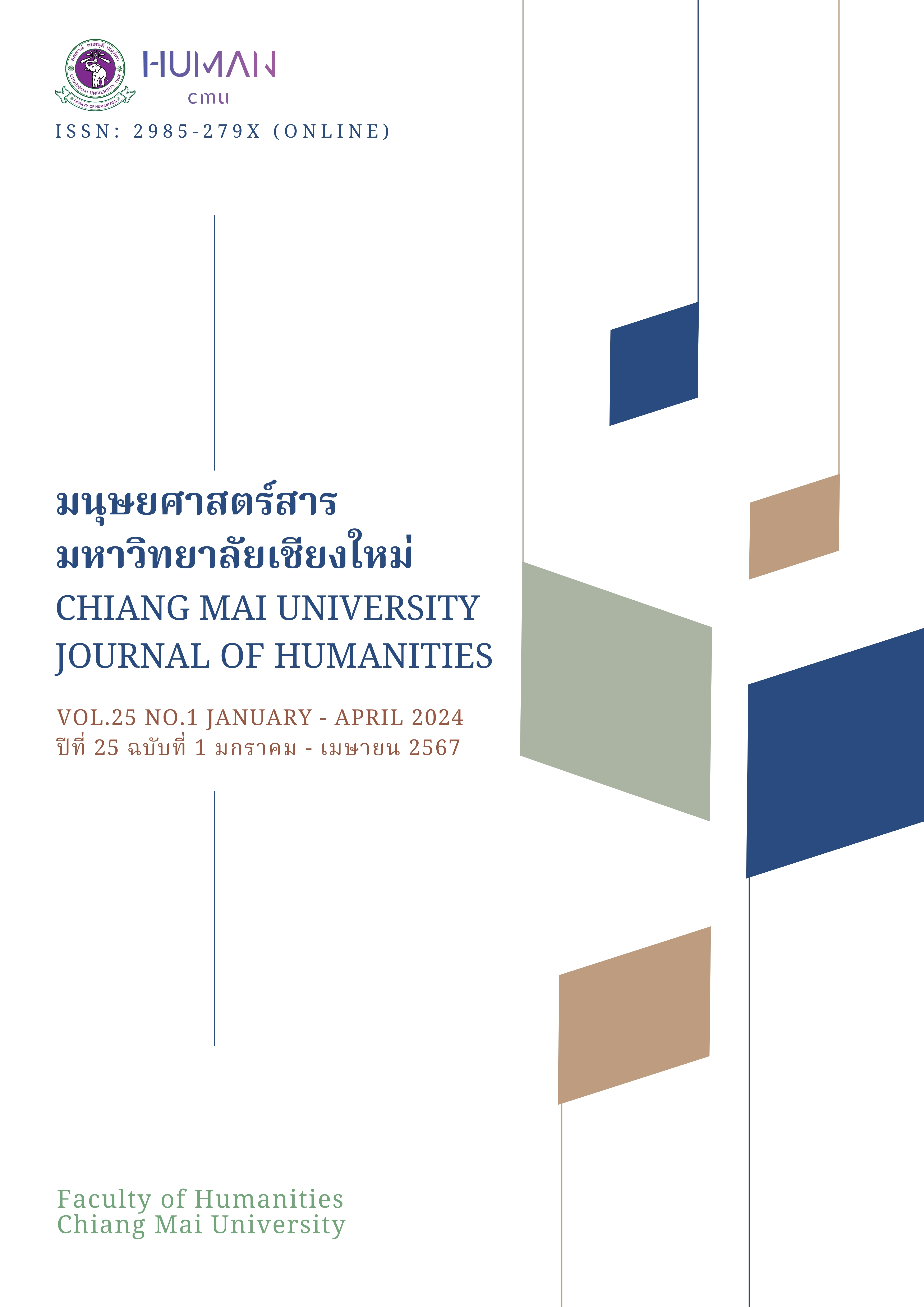ลักษณะทางกลสัทศาสตร์และประเภทของเสียงก้องพร่าที่ปรากฏกับวรรณยุกต์และโน้ตดนตรีในการร้องเพลงไทย
Main Article Content
บทคัดย่อ
บทความนี้มีวัตถุประสงค์เพื่อศึกษาคุณลักษณะทางกลสัทศาสตร์ของเสียงก้องพร่าที่ปรากฏในการร้องเพลงภาษาไทย เก็บข้อมูลจากผู้ร่วมวิจัยที่ประกอบอาชีพร้องเพลง เพศชาย 5 คน เพศหญิง 5 คน อายุตั้งแต่ 20 – 30 ปี แต่งเพลงภาษาไทยที่มีการควบคุมวรรณยุกต์ให้สมดุลในแต่ละโน้ตดนตรี บันทึกเสียงร้องของผู้ร่วมวิจัย ซึ่งถูกขอให้ใช้เสียงก้องพร่าได้ตามอัธยาศัย วิเคราะห์เสียงก้องพร่าที่ปรากฏในโน้ตดนตรีและวรรณยุกต์ โดยระบุประเภทย่อย อ้างอิงจากการศึกษาของ Keating et al (2015) รวมถึงวัดค่าระยะเวลาเสียงก้องพร่าจากเสียงสระทั้งหมด ผลพบว่า โน้ตดนตรีมีอิทธิพลต่อการปรากฏประเภทย่อยของเสียงก้องพร่าในแต่ละวรรณยุกต์ ซึ่งถึงแม้ว่าประเภทย่อยของเสียงก้องพร่าจะมีการกระจายตัวอย่างอิสระ แต่เป็นผลมาจากปฏิสัมพันธ์ของโน้ตดนตรีและวรรณยุกต์ ที่เลือกประเภทย่อยให้เหมาะสมในแต่ละระดับเสียง โดยภาพรวมพบว่า เสียงก้องพร่าแบบโวคอลฟรายมีสัดส่วนการใช้งานมากที่สุด โดยเฉพาะในช่วงโน้ตเสียงต่ำที่ปรากฏการใช้งานในผู้ร่วมวิจัยทุกคน นอกจากนี้ โน้ตดนตรียังส่งเสริมให้ระยะเวลาของเสียงก้องพร่านั้นแตกต่างกันไปด้วย และยังพบว่าวรรณยุกต์ที่มีระดับเสียงต่ำส่วนใดส่วนหนึ่ง เช่น วรรณยุกต์เอกและโท มักส่งผลให้ระยะเวลาเสียงก้องพร่ามากกว่าในวรรณยุกต์อื่นๆ อีกทั้ง ความพยายามในการรักษาระดับเสียงของวรรณยุกต์ตรี ในช่วงที่ระดับเสียงสูงขึ้น สามารถส่งผลให้ระยะเวลาของเสียงก้องพร่านั้นมากกว่าที่ปรากฏในวรรณยุกต์อื่นได้เช่นกัน
Article Details

อนุญาตภายใต้เงื่อนไข Creative Commons Attribution-NonCommercial-NoDerivatives 4.0 International License.
เอกสารอ้างอิง
ชวดล เกตุแก้ว. (2558). การทาบเทียบระหว่างเสียงวรรณยุกต์และโน้ตดนตรีในเพลงป๊อปไทย. วิทยานิพนธ์ ปริญญาดุษฎีบัณฑิต.จุฬาลงกรณ์มหาวิทยาลัย
Baart, J.L. (2004). Tone and song in Kalam Kohistani (Pakistan). Lot Occasional Series, 2, 5-15.
Brown, P., & Levinson, S. (1987). Politeness: Some Universals in Language Use. Studies in Interactional Sociolinguistics 4. Cambridge: Cambridge University Press.
Chappell, W., Nix, J., & Parrott, M. (2020). Social and stylistic correlates of vocal fry in a cappella performances. Journal of Voice, 34(1). https://doi.org/10.1016/j.jvoice.2018.06.004
Cleveland, T. F. (1994). A clearer view of singing voice production: 25 Years of progress. Journal of Voice, 8(1), 18–23. https://doi.org/10.1016/s0892-1997(05)80315-7
Dallaston, K., & Docherty, G. (2020). The quantitative prevalence of creaky voice (vocal fry) in varieties of English: A systematic review of the literature. PLOS ONE, 15(3). https://doi.org/10.1371/journal.pone.0229960
DiCanio, C T. (2009). The phonetics of register in Takhian Thong Chong. Journal of The International Phonetic Association - J INT PHON ASSOC. 39. 10.1017/S0025100309003879.
Frazier, M. (2009): The interaction of pitch and creaky voice: Data from Yucatee Maya and cross – linguistic implications. https://lingpapers.sites.olt.ubc.ca/files/2018/01/UBCWPL26- WSCLA1314-Frazier.pd
Gobl, C. & Chasaide, A. (2003). The role of voice quality in communicating emotion, mood and attitude. Speech Communication. 40. 189-212. 10.1016/S0167-6393(02)00082-1.
Gope, A., & Mahanta, S. (2016). Correlation between sylheti tone and phonation. Speech Prosody 2016. https://doi.org/10.21437/speechprosody.2016-63
Gordon, M., & Ladefoged, P. (2001). Phonation types: a cross-linguistic overview. Journal of Phonetics, 29(4), 383–406. https://doi.org/10.1006/jpho.2001.0147
Hornibrook J, Ormond T, Maclagan M. (2018). Creaky voice or extreme vocal fry in young women. N Z Med J. 131(1486):36-40. PMID: 30496165.
Keating, P.A., Garellek, M., & Kreiman, J. (2015). Acoustic properties of different kinds of creaky voice. ICPhS.
Kuang, J. (2017). Covariation between voice quality and pitch: Revisiting the case of Mandarin creaky voice. The Journal of the Acoustical Society of America, 142(3), 1693–1706. https://doi.org/10.1121/1.5003649
Laver, J. (1980). The phonetic description of voice quality. Cambridge University Press.
Melvin, S., & Clopper, C.G. (2015). Gender variation in creaky voice and fundamental frequency. ICPhS.
Nix, J. (2016). Why fry? An exploration of the lowest vocal register in amplified and unamplified singing. Proceedings of Meetings on Acoustics. 26. 035001. 10.1121/2.0000210.
Podesva, R. (2007). Phonation Type as a Stylistic Variable: The Use of Falsetto in Constructing a Persona. Journal of Sociolinguistics. 11. 478 - 504. 10.1111/j.1467-9841.2007.00334.x.
Podesva, R. J. (2011). Gender and the social meaning of non-modal phonation types. Annual Meeting of the Berkeley Linguistics Society, 37(1), 427. https://doi.org/10.3765/bls.v37i1.832
Schellenberg, M. H. (2013). The realization of tone in singing in Cantonese and Mandarin. A Thesis of Doctor of Philosophy. The University of British Columbia
Yuasa, I. P. (2010). Creaky voice: A new feminine voice quality for young urban-oriented upwardly mobile American women? American Speech, 85(3), 315–337. https://doi.org/10.1215/00031283-2010-018
Zsiga E, Nitisaroj R. (2007). Tone features, tone perception, and peak alignment in Thai. Lang Speech. 50(Pt 3):343-83. doi: 10.1177/00238309070500030301. PMID: 17974323.


